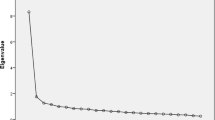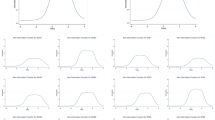Abstract
The convergent and discriminant validity of the Social Interaction Self-Statement Test (SISST) were evaluated in a sample of men and women awaiting treatment for fear and avoidance of social interactions. Partial correlations revealed that negative, but not positive, self-statement scores were generally related to self-report measures of anxiety and depression. Heart rate and subjective anxiety ratings derived from a behavioral simulation of a personally relevant anxiety-provoking situation were unrelated to SISST scores. However, subjects' reports of negative thoughts obtained via the thought-listing procedure were related to the SISST negative self-statement scores, suggesting that the negative subscale of the SISST and the thought-listing procedure tap similar dimensions. Finally, the negative subscale of the SISST discriminated between social phobics whose primary fear involved social interactions and social phobics whose anxiety was confined to public-speaking situations. The findings support the use of the SISST with clinically socially anxious patients.
Similar content being viewed by others
References
American Psychiatric Association (1980).Diagnostic and statistical manual of mental disorders (3rd ed.). Washington, D.C.: Author.
Barlow, D. H. (1985). The dimensions of anxiety disorders. In A. H. Tuma & J. D. Maser (Eds.),Anxiety and the anxiety disorders (pp. 479–500). Hillsdale, New Jersey: Erlbaum.
Beck, A. T., & Emery, G. (1985).Anxiety disorders and phobias: A cognitive perspective. New York: Basic Books.
Beck, A. T., Ward, C. H., Mendelson, M., Mock, J., & Erbaugh, J. (1951). An inventory for measuring depression.Archives of General Psychiatry, 4 561–571.
Cacioppo, J. T., Glass, C. R., & Merluzzi, T. V. (1979). Self-statements and self-evaluations: A cognitive-response analysis of heterosocial anxiety.Cognitive Therapy and Research, 3 249–262.
Cohen, J., & Cohen, P. (1983).Applied multiple regression/correlation analysis for the behavioral sciences (2nd ed.). Hillsdale, New Jersey: Erlbaum.
DiNardo, P. A., O'Brien, G. T., Barlow, D. H., Waddell, M. T., & Blanchard, E. B. (1983). Reliability of DSM-III anxiety disorder categories using a new structured interview.Archives of General Psychiatry, 40 1070–1074.
Fenigstein, A., Scheier, M. R., & Buss, A. H. (1975). Public and private self-consciousness: Assessment and theory.Journal of Consulting and Clinical Psychology, 43 522–527.
Glass, C. R., Gottman, J. M., & Schmurak, S. H. (1976). Response-acquisition and cognitive self-statement modification approaches to dating skills training.Journal of Counseling Psychology, 23 520–526.
Glass, C. R., Merluzzi, T. V., Biever, J. L., & Larsen, K. H., (1982). Cognitive assesment of social anxiety: Development and validation of a self-statement questionnaire.Cognitive Therapy and Research, 6 37–55.
Heimberg, R. G., Acerra, M. C., & Holstein, A. (1985). Partner similarity mediates interpersonal anxiety.Cognitive Therapy and Research, 9 443–453.
Heimberg, R. G., Chiauzzi, E. J., Becker, R. E., & Madrazo-Peterson, R. (1983). Cognitive mediation of assertive behavior: An analysis of the self-statement patterns of college students, psychiatric patients, and normal adults.Cogntive Therapy and Research, 7 455–464.
Heimberg, R. G., Dodge, C. S., & Becker, R. E. (1987). Social phobia. In L. Michelson & M. Ascher (Eds.),Anxiety and stress disorders: Cognitive behavioral assessment and treatment (pp. 280–309). New York: Plenum Press.
Heimberg, R. G., Gansler, D., Dodge, C. S., & Becker, R. E. (1987). Convergent and discriminant validity of the Cognitive-Somatic Anxiety-Questionnaire in a social phobic population.Behavioral Assessment, 9 379–388.
Heimberg, R. G., Keller, K. E., & Peca-Baker, T. (1986). Cognitive assessment of social-evaluative anxiety in the job interview: The Job Interview Self-Statement Schedule.Journal of Counseling Psychology, 33 190–195.
Heimberg, R. G., Madsen, C. H., Jr., Montgomery, D., & McNabb, C. E. (1980). Behavioral treatments for heterosocial problems: Effects on daily self-monitored and roleplayed interactions.Behavior Modification, 4 147–172.
Heimberg, R. G., Nyman, D., & O'Brien, G. T. (1987). Assessing variations of the thought-listing technique: Effects of instructions, stimulus intensity, stimulus modality, and scoring procedures.Cognitive Therapy and Research, 11 13–24.
Hollon, S. D., & Kendall, P. C. (1980). Cognitive self-statements in depression: Development of an automatic thoughts questionnaire.Cognitive Therapy and Research, 4 383–395.
Kanter, N. J., & Goldfried, M. R. (1979). Relative effectiveness of rational restructuring and self-control desensitization in the reduction of interpersonal anxiety.Behavior Therapy, 10 472–490.
Kendall, P. C., & Hollon, S. D. (1981). Assessing self-referent speech: Methods in the measurement of self-statements. In P. C. Kendall & S. D. Hollon (Eds.),Assessment strategies for cognitive-behavioral interventions (pp. 85–118). New York: Academic Press.
Kendall, P. C., Williams, L., Pechacek, T. F., Graham, L. G., Shisslak, C. S., & Herzoff, N. (1979). Cognitive-behavioral and patient education interventions in cardiac catheterization procedures: The Palo Alto medical psychology project.Journal of Clinical and Consulting Psychology, 47 49–58.
Lang, P. J. (1968). Fear reduction and fear behavior: Problems in treating a construct. In J. M. Shlien (Ed.),Research in psychotherapy (Vol. 3, 90–103). Washington, D.C.: American Psychological Association.
Merluzzi, T. V., Burgio, K. L., & Glass, C. R. (1984). Cognition and psychopathology: An analysis of social introversion and self-statements.Journal of Consulting and Clinical Psychology, 52 1102–1103.
Paul, G. L. (1966).Insight vs. desensitization in psychotherapy. Stanford, California: Stanford University Press.
Rachman, S., & Hodgson, R. (1974). I. Synchrony and desynchrony in fear and avoidance.Behaviour Research and Therapy, 12 311–318.
Schwartz, R. M., & Gottman, J. M. (1976). Toward a task analysis of assertive behavior.Journal of Consulting and Clinical Psychology, 44 910–920.
Schwartz, R. M., & Garamoni, G. L. (1986). A structural model of positive and negative states of mind: Asymmetry in the internal dialogue. In P. C. Kendall (Ed.),Advances in cognitive-behavioral research and therapy (Vol. 5, pp. 1–62). New York: Academic Press.
Spielberger, C. D., Gorsuch, R. W., & Lushene, R. E. (1970).State-trait anxiety inventory. Palo Alto: Consulting Psychologists Press.
Turner, S. M., & Beidel, D. C. (1985). Empirically derived subtypes of social anxiety.Behavior Therapy, 16 384–392.
Watson, D., & Friend, R. (1969). Measurement of social-evaluative anxiety.Journal of Consulting and Clinical Psychology, 33 448–457.
Watson, J. P., & Marks, I. M. (1971). Relevant and irrelevant fear in flooding: A crossover study of phobic patients.Behavior Therapy, 2 275–295.
Wolpe, J., & Lazarus, A. A. (1966).Behavior therapy techniques. Oxford: Pergamon Press.
Work Group to Revise DSM-III. (1986).DSM-III-R in development (2nd draft). American Psychiatric Association.
Zweig, D. R., & Brown, D. S. (1985). Psychometric evaluation of a written stimulus presentation format for the Social Interaction Self-Statement Test.Cognitive Therapy and Research, 9 285–195.
Author information
Authors and Affiliations
Rights and permissions
About this article
Cite this article
Dodge, C.S., Hope, D.A., Heimberg, R.G. et al. Evaluation of the Social Interaction Self-Statement Test with a social phobic population. Cogn Ther Res 12, 211–222 (1988). https://doi.org/10.1007/BF01204932
Issue Date:
DOI: https://doi.org/10.1007/BF01204932



